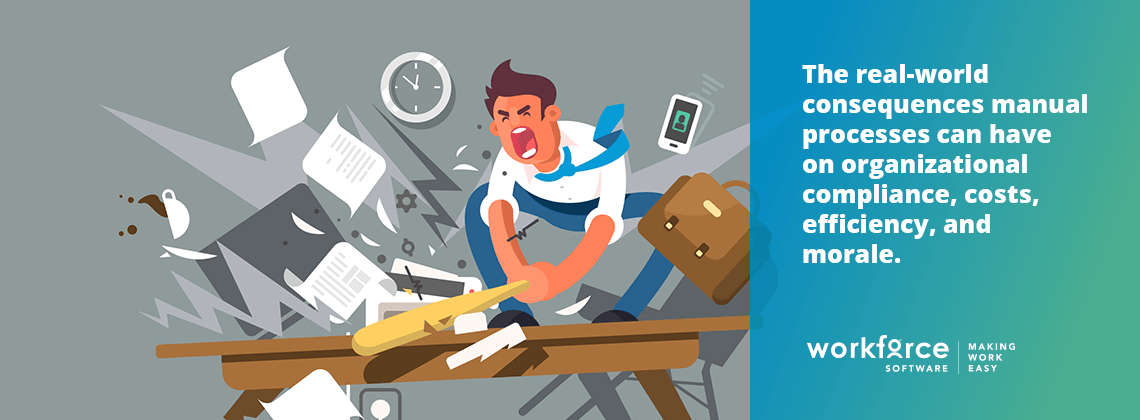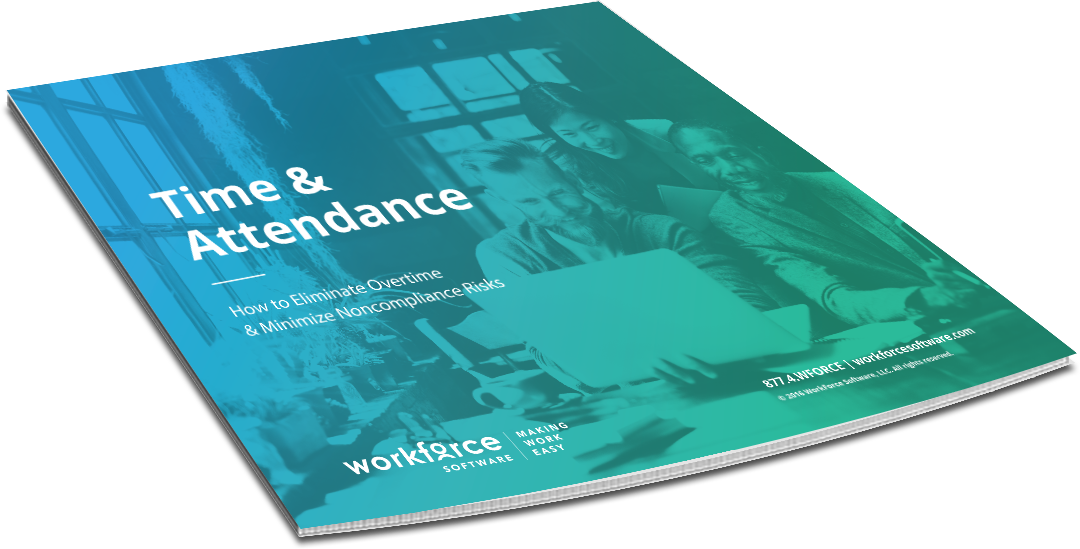What Happens When Modern Organizations Neglect Their Workforce Management

If you manage people, you should meet Francesca, Alex, Bella, and Dan.
Their stories tell what happens when modern organizations neglect their workforce management, a choice that touches virtually every aspect of a business, including:
1. Compliance
Alex is a foreman at a manufacturing plant.
He’s sat at his desk. The glass panel behind him overlooks the facility below. In front of him Ross, from HR, and Rachel, from Legal, are frowning.
“There’s been a complaint,” says Ross.
“An employee wasn’t paid correctly,” adds Rachel. “Over and over.”
“Sometimes his check was off by half,” says Ross. “He’s suing us.”
Alex shifts in his chair. “Oh,” he says. “Really?”
“We need this information for court,” says Rachel, plopping a spreadsheet with 47 line items on the desk. “Please.”
Alex puts on his glasses and scans the paper. “Some of this is from last year,” he says. “And the year before that,” he turns the page, “and the year before that.” He takes off his glasses. “I have some of this, but not all of it.”
Rachel leans back in her chair. “The less you have, the harder this case will be to win.”
Manual processes put you in legal jeopardy.
Contracts, statements of work, time-sheets, and other employee documents can prove an organization’s compliance.
But analog records can get lost in the shuffle, rendering them useless when they matter most.
 Time & Attendance: How to Eliminate Overtime & Minimize Noncompliance Risks
Time & Attendance: How to Eliminate Overtime & Minimize Noncompliance Risks
Are the gaps in your HCM suite covered? Learn how a dedicated time and attendance solution can help eliminate over-payments and minimize non-compliance risks.
2. Costs
Francesca manages a furniture store.
It’s Monday. Francesca is stood over her desk, rooting through a pile of papers. She’s trying to find the “Time-Off” spreadsheet: Glenn requested 5 days off next week.
“Got it,” she says under her breath. She assumes Glenn, a tenured employee, has the time. She approves his request and gets to work updating next week’s schedule:
- Jane, who’s working 20 hours that week, gets a couple extra shifts, bringing her total hours to 36.
- Erin, who’s working 3 days that week, also gets a few shifts, bringing him up to 5 days.
Francesca gives the revised schedule a quick scan. Looks good. She submits it and goes home. She doesn’t yet know that her schedule won’t work. That it’s fiscally and practically broken because:
- Glenn had not yet accrued the hours for a five-day leave: he’s only entitled to 4 days.
- Jane had recently switched from fulltime to part: she can only work 27 hours a week.
- Erin had picked up those extra shifts without mentioning that his 3 other days were composed of 12-hour shifts: he’s now entitled to overtime pay.
It’s Monday. Francesca is in her office again, in the back, separated from her employees on the sales floor, separated from her customers. She’s trying to fix her mistakes.
Manual processes affect your bottom line.
People make mistakes. Not because they’re bad or incompetent, but because they’re people, hurried and careless sometimes.
Managers accidentally misclassify employees, or approve unallowable leave, or schedule unnecessary overtime—and every error costs money.
3. Efficiency
Bella manages a kitchen supply chain.
It’s 4:35. Bella is at her desk with a calculator, an employee skill matrix, a stack of HR records, and some grid paper. She has to create next week’s schedule, fast, then race to the airport. Her mom’s flight is arriving early.
Bella’s store is big, divided into three sections: A, B, and C. Employees are scheduled to work a single section based on their skills, knowledge, availability, and tenure.
Section “A” is receiving a big order: 200 units need to be unpacked, prepped, and placed. After studying the skill matrix and calculating the time need, she schedules 4 people to work 8-hour shifts. “That should do it,” she says, thinking out loud.
Section “B” has a typical week ahead: she charts her usual team.
Section “C” is undergoing a design overhaul: signage and displays need to be taken down, moved, and rebuilt. It’s a big project that demands various specific skills. Given the nature of the work, there’s also a minimum employee age. Bella chews her pen cap as she scans the matrix, the HR records, and the availability chart, juggling the variables in her head.
It’s 5:50. Bella puts down her pen. “Done.”
Then she sees the Post-it on her monitor. She’d forgotten:
Frankie OUT: Monday
Aaron OUT: Wednesday
“Oh, no.”
This throws everything off—all those variables—the entire schedule!
Bella texts her mom, asking her to take a cab instead. “I’ll make it up to you,” she writes, reaching for a fresh sheet of grid paper. Her mouth is dry.
Manual processes burn time and people.
Scheduling the right people to be in the right place at the ideal time boils down to knowing your numbers.
Bad data can lead to over-scheduling or understaffing, which drains time, depletes budgets, and decimates morale.
4. Morale
Dan is a maintenance specialist at an automotive plant.
It’s Friday, payday, Dan’s favorite day. He clocks out and walks out. Then his phone goes off.
“Come to the bar,” says Brett.
“Well, well,” says Dan, “twist my arm! Which?”
“We’re at Jolly Anchor’s,” says Brett.
An hour later, Dan walks in. “I got the next round.”
He walks over to the ATM, inserts a card and enters a pin. The machine gives him some money and a receipt. Dan glances over it.
“No,” he says. “Not again.” He’s felt this way before, the last time his paycheck was off by half. And the time before that. And the time before that. Last time, Payroll said ‘they didn’t have him down for working so much.’
“We just don’t have you down for working so much,” said the Payroll person.
He took his card and walked back to the group, flushed.
“Everything alright?” says Brett.
“Yeh,” says Dan. “Hey you know a good lawyer?”
Manual processes give way to payroll errors.
These mistakes chip away at employee trust, creating resentment, disengagement, and turnover.
Subscribe to The WorkForce Blog
Learn the art and science of maintaining productive, happy, engaged employees.
There’s a better way.
Workforce management software automates manual processes.
It automates pay rules and leave management. It automates scheduling and attendance as well as work rules and union contracts and overtime reporting.
Workforce management software provides leaders with data, real-time insights that drive better decisions. Decisions that save money and drive employee engagement. Decisions that make customers smile.

 Time & Attendance: How to Eliminate Overtime & Minimize Noncompliance Risks
Time & Attendance: How to Eliminate Overtime & Minimize Noncompliance Risks